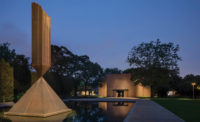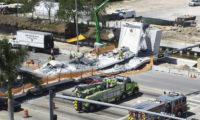Mid-Construction Discovery Causes Delay, Increases Cost of Rothko Chapel Restoration

A rendering of the restored interior of the Rothko Chapel shows the new skylight.
Rendering © Architecture Research Office

Interior of the Chapel, as seen in 1971
Photo © Hickey-Robertson

Interior of the Chapel, as seen in 1999, when a baffle had been installed beneath the skylight to filter sunlight
Photo © Hickey-Robertson

A rendering of the restored plaza shows Barnett Newman’s Broken Obelisk sculpture, dedicated to Dr. Martin Luther King, Jr., rising above the reflecting pool.
Rendering © Nelson Byrd Woltz Landscape Architects

Path through the new North Campus to the plaza
Rendering © Architecture Research Office

North Campus, looking east across Sul Ros
Rendering © Architecture Research Office

North Campus, looking west across Sul Ros
Rendering © Architecture Research Office

Meeting room
Rendering © Architecture Research Office

Isometric Site Plan
Drawing © Architecture Research Office









During the first phase of a $30 million construction project to restore the Rothko Chapel and expand its campus in Houston, engineers made a discovery that will add four months and $1.1 million to the rehabilitation of the 1971 structure, which is home to 14 monumental paintings by Mark Rothko.
The Chapel’s concrete masonry walls, which stand some 25 feet tall, were originally built without steel reinforcement—an acceptable practice in the 1970s, when Philip Johnson, Howard Barnstone, and Eugene Aubry designed it. If such a structure were built today, contemporary codes would require that the concrete masonry units (CMUs) be reinforced with steel rebar to withstand lateral wind loads of 130 miles per hour.
According to Stephen Cassell and Adam Yarinsky of New York–based Architecture Research Office (ARO), which is leading the master plan, the building could be “grandfathered in,” by code, without further intervention because of when it was constructed. “But it doesn’t seem prudent, given the height of wall,” says Yarinsky. “The goal is that the chapel be protected for the long term”—especially important in a city where intense hurricanes occur with increasing frequency.
Making this discovery was “a really big deal,” Rothko Chapel Executive Director David Leslie tells RECORD, causing the non-profit organization—which balances art, spirituality, and social justice—to examine the implications for time, expense, and the public. “It has caused us to push some programs that we would have held here off campus, to other institutions,” he says. “But we felt that from a stewardship, safety, and fiduciary position, we had no alternative but to do this. We quickly said this is something we are going to do.”
So how will the reinforcement be achieved? “Carefully!” emphasizes Yarinsky. ARO worked with Cardno, the Houston-based structural engineering firm, and Linbeck, a local construction firm, to devise a minimally invasive way of filling voids in the CMUs with grout and steel rebar via slots, cut into the walls every 24 inches. “It’s like resoling your shoes, while you’re standing up, without lifting them,” says Cassell.
The team has had to remove the existing interior plaster (largely planned to be replaced for acoustical improvements), as well as a small area of exterior brick. As much of the original brick as possible will be saved and reused, say the architects, but some new bricks from the same manufacturer will be integrated with old ones as the wall is repaired. “We were lucky that the original company still exists and is still making the same brick,” says Yarinsky.

The Chapel is now expected to reopen in May or June of 2020. In addition to the reinforced walls, the project will improve lighting within the space with a new skylight, louvers, and light fixtures; increase the building’s resiliency, with a new above-ground emergency generator and a system of doorway floodgates; and upgrade the acoustics, A/V system, and certain spaces, such as the entry vestibule.
“We are carefully and subtly integrating new architecture, and trying to understand the goals of the original building,” says Cassell. “It’s important to think about the intent behind Rothko’s, Johnson’s, and [founders John and Dominique] de Menil’s early decisions, so we are restoring some things, and doing other things that they would have done, if they were able.”
The $31 million master plan, to be fully realized in multiple phases by 2023, includes several new buildings to comprise a new North Campus: an energy facility, visitor welcome house, program center, and an administration and archives building. ARO will lead the design, collaborating with lighting design firm George Sexton Associates inside the Chapel and Nelson Byrd Woltz Landscape Architects on the grounds and plaza.












